As the World Burns
Indigenous wisdom on megafires as the Lungs of the World blaze | ISSUE 22, Aug. 23, 2019
QUICK/READ | The ‘Lungs of the World’ are burning and you can see it from outer space. Seasonal fires are not new in the Amazon rainforest. But the scope of mega-fires happening now are. They are more extreme from Brazilian politics and beef production for the mega-fast food industry. What to do? Consider a beef boycott. Or at least cut back by heading beyond burgers. And what does Dr. Banksy prescribe for eco-despair? Read his diagnosis below. Follow us on Twitter at @TimesClimate. Subscribe to this newsletter and podcast at changingclimatetimes.substack.com.

ONE | Coughing Up ‘The Lungs of the World’
As Ryan Hagan notes in the recent issue of his Crowdsourcing Sustainability newsletter: “Civilization’s house is on fire and needs to be put out ASAP.” (Subscribe here to get his informed weekly newsletter and join Ryan’s effort to spur collective action on climate change.)
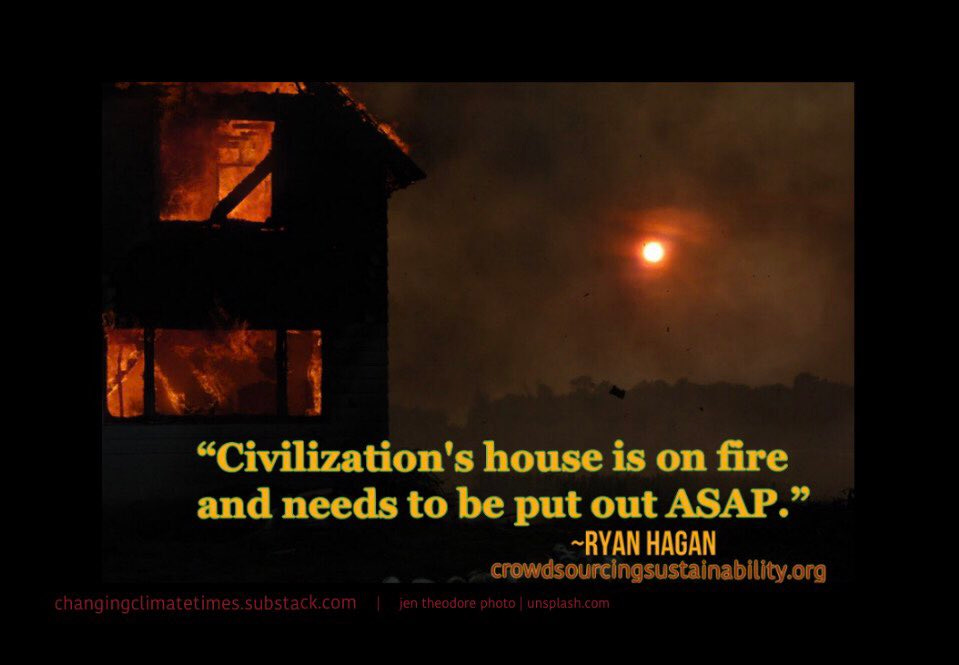
To be even more specific, the world’s lungs are on fire.
You’d have to be a cave dweller or living inside a Fortress of Solitude to be unaware of the mega-fires burning through the #AmazonRainforest. Amazonia, as it’s sometimes called, includes one-third of the world’s remaining rainforests. It’s so big it produces 20 percent of Earth's total oxygen, which is why the Amazon rainforest is called "the Lungs of the World."
To visualize its size, the Amazon rainforest is about the size of the 48 contiguous United States. It sprawls across no less than 40 percent of the whole South American continent. The current fires are so widespread they can be seen from outer space:

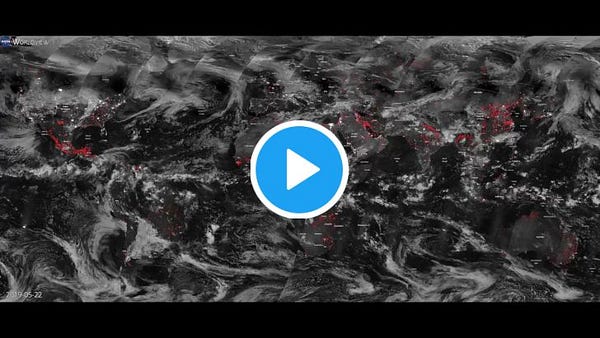
You’ll hear pushback from climate deniers that such fires are seasonal in Amazonia. But as Greenpeace forest campaigner Juman Kubba told the BBC in this audio piece, “Why Is the Amazon Burning?”, the politics of Brazil and corporate supply lines that feed the maw of fast-food chains, play a key role in torching the Amazon.
Kubba said there has been a 145 percent increase in fires in 2019 compared to last year, with the rise to power of Brazilian President Jair Bolsonaro. As the BBC piece notes:
Forest fires are common from July to October. But activists say Brazilian President Bolsonaro’s policies have encouraged farmers to clear land for crops or grazing—resulting in an increase in fires.
“The scale of this is new,” says Kubba. “The rate which were seeing fires is unprecedented. That’s incredible growth … This is the lungs of the planet that are on fire.”
She then makes an important point—one that points directly to what many of us put in our mouths.
Vast sections of the Amazon rainforest are being burned out to raise crops linked to international trade. Says Kubba: “When we go to big fast-food giants like KFC, McDonalds or Burger King, the burgers that we eat will be coming from animals that are fed on animal feed which is grown in places like Brazil.”
And that can be part of the solution, she says. Those fast-food mega-corporations “have tremendous power to influence what is being done and not done in Brazil,” says Kubba. “So, we should be asking them to change their ways.”
At the level of international trade, that also means putting a hold on trade agreements, Kubba says, until "Amazonia is protected and we really have environmental and human rights protection at the heart of trade deals.”

TWO | Enter the Boycott
Wait. You mean my double cheeseburger is part of the problem?
For more on that, let’s turn to a thread on the topic by writer Nylah Burton. Click the thread open down below. If you’re not on Twitter, let’s summarize in a single sentence: “If you want to do something about the #AmazonRainforest and the killing of indigenous people, the easiest and most impactful thing you can do is stop eating beef.”

Now, that sounds way too easy. Yet Burton is not being glib and superficial. Just as the taste of the ocean can be found in a single drop of its water, a single hamburger—multiplied by the billions—can contribute to the collapse of the Lungs of the World.
Burton wrote a Aug. 23, 2019 piece for Medium’s Tenderly, expanding on her thread above. The title is just as pointed as her thread: “The Amazon Rainforest Is Burning and You Can Help: Stop Eating Beef: The time for change is right now.”
A brief interruption here. A word here about my lovely wife.
She has patiently watched me craft a beachhead as a teensy climate change communicator (and recent climate podcaster). Whenever I talk about my climate-comm efforts, her standard reply is: “Just tell me what to do!”
Burton is telling folks what to do. At the risk of sending you packing to #CatsofInstagram, please bear with me as Burton lays out her argument:
The boycott is a tried and true method of resistance. But if you live in Europe, China, the United States, Canada, or Australia, you may think your boycott can’t help save the Amazon rainforest, or support the Indigenous people of Brazil.
But your money—especially if you eat beef and other meats—is almost certainly funding the degradation of the Amazon rainforest.
The Articulation of Indigenous Peoples of Brazil (APIB) released a comprehensive report titled “Complicity In Destruction II: How Northern Consumers and Financiers Enable Bolsonaro’s Assault on the Brazilian Amazon.” The report details the Indigenous-led call for people in the aforementioned countries to boycott certain Brazilian products and businesses that invade their lands and engage in illegal deforestation for profit.
The APIB report says that “Ranching alone leads to approximately 80% of Amazon deforestation, with 80% of Amazon forests cleared since 2014 being occupied by cattle,” and bringing in $5.4 billion for Brazil in 2017. The report also implicates the soy industry in deforestation, saying that in 2017, Brazilian soy generated $31 billion.”
Eloy Terena, APIB’s legal counsel, said: “Traders in Europe and North America can help by cutting ties with these bad Brazilian actors, thus sending a clear signal to Jair Bolsonaro that the rest of the world will not tolerate his policies.”
Burton’s article goes on to note:
There are many Brazilian products that are contributing to deforestation, like timber and fossil fuels. But beef is an incredibly easy product to boycott—barring any medical or cultural needs that require beef consumption, of course.

THREE | Getting Beyond Beef

Unlike most veggie burger substitutes, Beyond Burgers are made of pea protein, not soy.
It may be a bridge too far for lifelong, committed carnivores to immediately stop eating beef cold turkey. (Apologies if I just started your saliva glands salivating at the idea of cold turkey sandwiches.)
But for those folks deepening awareness of the relation between mega-corporation meat, climate change and Amazonian deforestation, perhaps crack open that door by first cutting back. And voting for non-beef vegetarian substitutes like Burger King’s Impossible Burger (which is soy-based, which has its own seperate issues.) But kudos to one fast-food giant for baby steps.
A personal note. My household claims no high moral ground. My wife and I have been vegetarians for a long while, but I know how hard it might be to boycott, if not end, the eating of beef.
But test out a boycott, if not a transition from beef, by trying the pretty amazing Beyond Burgers. Unlike most other “veggie” hamburger-like patties made from soy, Beyond Burgers are made of pea protein. Their recently released version 2.0, which added an even fattier blend, is plain scrumptious.
PS: And that blood in the frying pan? Elsie the Cow and tracts of rainforest were not sacrificed for your Beyond Burger. It’s beet juice. PSS: And no, I’m not on retainer for Beyond Burgers. But the company is welcome to send me any new products they launch. Isn’t it time for Beyond Tofurkey?

FOUR | Let’s Control Ourselves
Unlike what’s happening in Amazonia, there is a wise use of fire in this climate-changing age.
Below is a superb use of illustration to make clear a point about the practice of prescribed burns in our era of mega-fires fueled by climate change. In less than 30 panels, this graphic comic-style explainer teaches how indigenous folk used fire to rejuvenate the landscapes of their homelands.
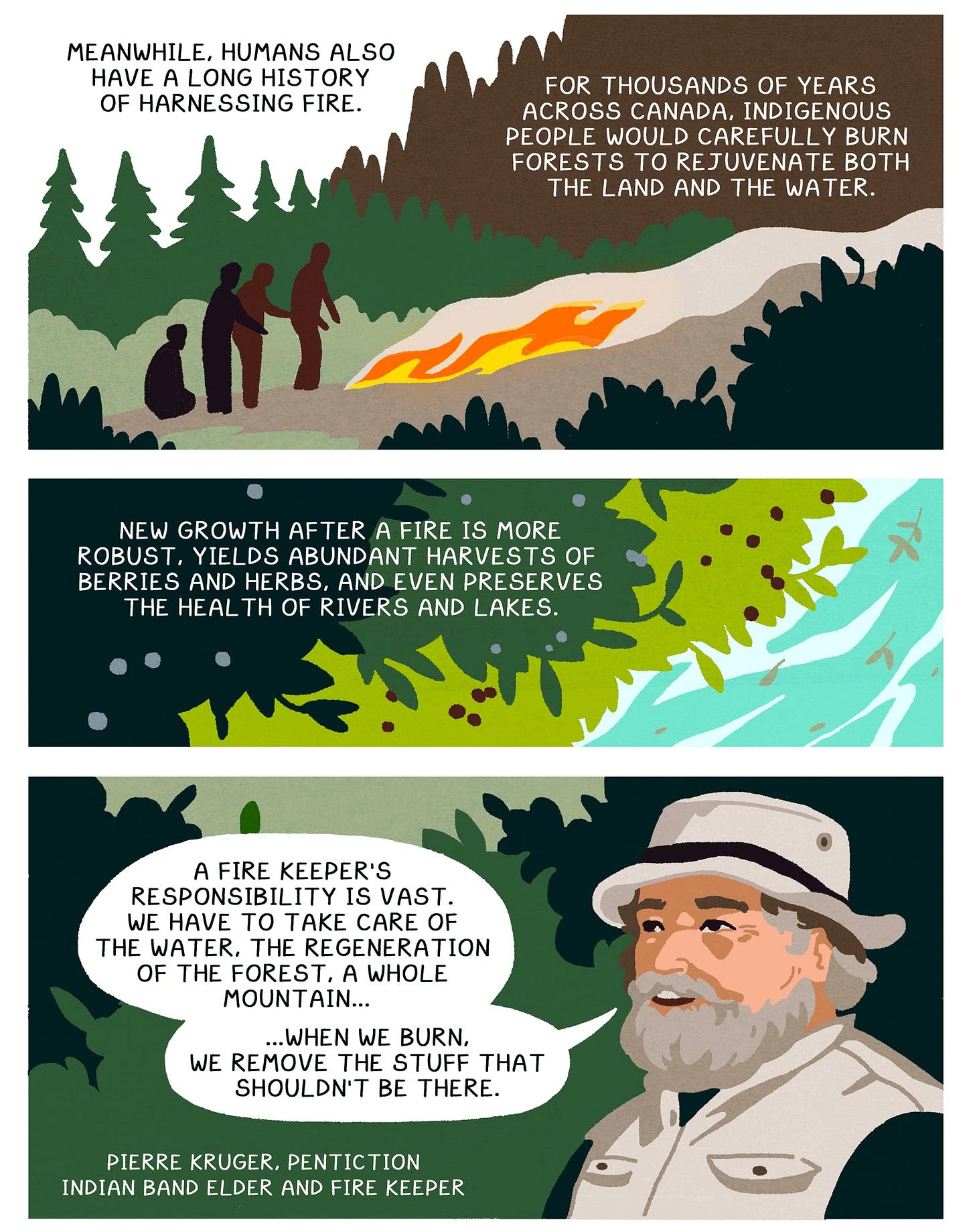
See the whole graphic at this link at The Nib.
Prescribed burns are, of course, a widely used tool in modern forest and prairie management. But we’ve created tinderboxes in many regions from ill-conceived fire suppression and unwise growth. Stroke the matchstick of climate change—and deadly infernos explode from all that densely packed biomass.
See the full version by Xulin Wang, in the Aug. 16, 2019 issue of The Nib: “Prescribed Burn: To prevent increasingly massive wildfires we need to rethink our approach to forest management.” The piece showcases a welcome indigenous contribution to the climate change conversation. Plus, it’s a master class in climate communication, using graphics, sourced material and old wisdom to capture the attention of readers.

FIVE | Strike Now
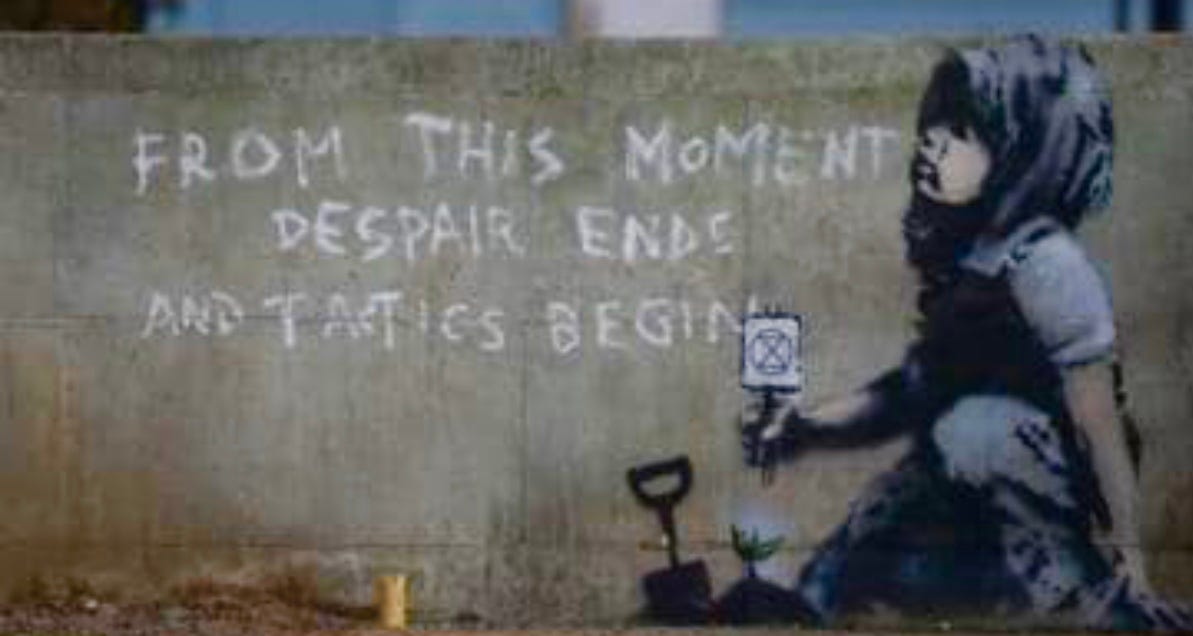
Banksy paints some good advice.
The pace of climate change and fears for our future can feel overwhelming. There’s a reason there’s a growing field devoted to “eco-despair.” But taking action, however small and local—or maybe especially local, in your town—is one key antidote.
Or, as prescribed by Doctor Banksy, in the graffiti above on a London wall:
“FROM THIS MOMENT DESPAIR ENDS AND TACTICS BEGIN.”
Note that microphone held by the kid. It’s the logo of the activist, take-it-to-the-streets group Extinction Rebellion.
Young folks have been taking it to the streets for awhile now. They invite adults to join them for a planet-wide global climate strike coming the week of Sept. 20 to 27, 2019.
Plan a local action where you live at globalclimatestrike.net.


PS | You Promised Cartoons
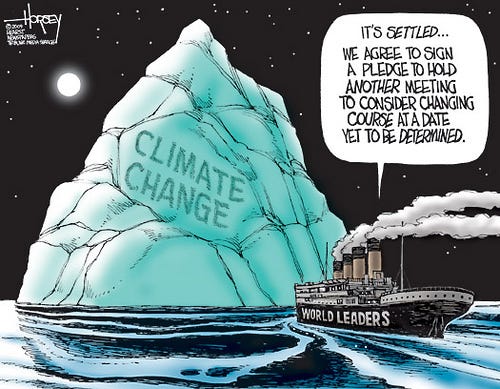
If this issue was forwarded to you, subscribe to the newsletter & podcast at: changingclimatetimes.substack.com | Subscribe to the podcast on iTunes and wherever you listen to podcasts. | Follow us on Twitter at @TimesClimate | Send feedback and suggestions to: douglasjohnmartin AT icloud.com.
And remember: Change the World. Not the big one.. The one in which you live. And love.
Be well. | CCT Curator, Concierge and Host Douglas John Imbrogno


